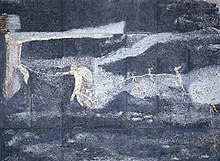Jeanne Reynal
Jeanne Reynal (1903-1983) was an American mosaic artist.[1] Her work is displayed at the Museum of Modern Art, Whitney Museum of American Art, San Francisco Museum of Modern Art, Denver Art Museum, Ford Foundation, New York University, Phillips Academy, and Los Angeles County Museum of Art.[2] Her personal papers from 1942 to 1968 are included in the Archives of American Art. The estate of Jeanne Reynal is represented by Eric Firestone Gallery in New York. [3]

Early life
Reynal was born in 1903 in White Plains, New York.[4] She was the second of five children.[4] When Reynal was nine years old, her parents separated.[4] She moved to Millbrook, New York with her father where she was taught by a governess.[4] Her other siblings continued to live with her mother.[4]
Early career
At the age of twenty-four, Reynal spent a summer to England, France, and Italy with her siblings and her mother.[4] It was during this trip that Reynal first met the Russian mosaicist Boris Anrep.[4] Two years later, Reynal began an apprenticeship with Anrep in Europe after assisting him with a mosaic he installed in the Bank of England.[4] The two also became romantically involved until Anrep left Reynal for a wealthy Englishwoman.[4] The two only saw each other once after this separation.[4] According to a series of letters written back and forth with Arshile Gorky, Reynal also studied under the painter.[5]
Reynal left Paris in 1937 and moved to California, where she worked in a potting shed in Marin County.[4] She then moved to the High Sierras, where she built a house and studio.[4]
After living in California for eight years, Reynal returned to her Greenwich Village, New York. studio in 1946.[4]
She married the painter Thomas Sills in 1953.[6]
Art and Mosaics
Reynal was known as a pioneer of mosaics during the New York Abstract Expressionist Movement. Her work prompted a rebirth of ancient mosaic techniques in the modern art world. In addition, Reynal freed the mosaic from the traditional confines of architectural settings. Reynal embraced the layered effect of mosaics, as they could stand alone, be apart of architecture, or engage with nature.[7] She was inspired by Byzantine mosaics as well as artwork by Mexican, Greek, and American Southwestern artists. Her work discusses mythology through a culturally modern setting.[8] In this way, her mosaic work became accessible to the contemporary art world.
References
- "Jeanne Reynal". www.whitney.org. Archived from the original on 2019-04-11. Retrieved 2019-04-11.
- "Jeanne Reynal".
- "Jeanne Reynal papers, 1942-1968". www.aaa.si.edu. Archived from the original on 2019-04-11. Retrieved 2019-04-11.
- Munro, Eleanor (2000). Originals: American women artists. Da Capo. ISBN 0306809559. OCLC 902208717.
- "Jeanne Reynal". Anita Shapolsky Gallery.
- "Jeanne Reynal". FADA.
- Campbell, Lawrence. The Mosaics of Jeanne Reynal. pp. 15–33.
- "Jeanne Reynal A Good Circular God 1948-50".